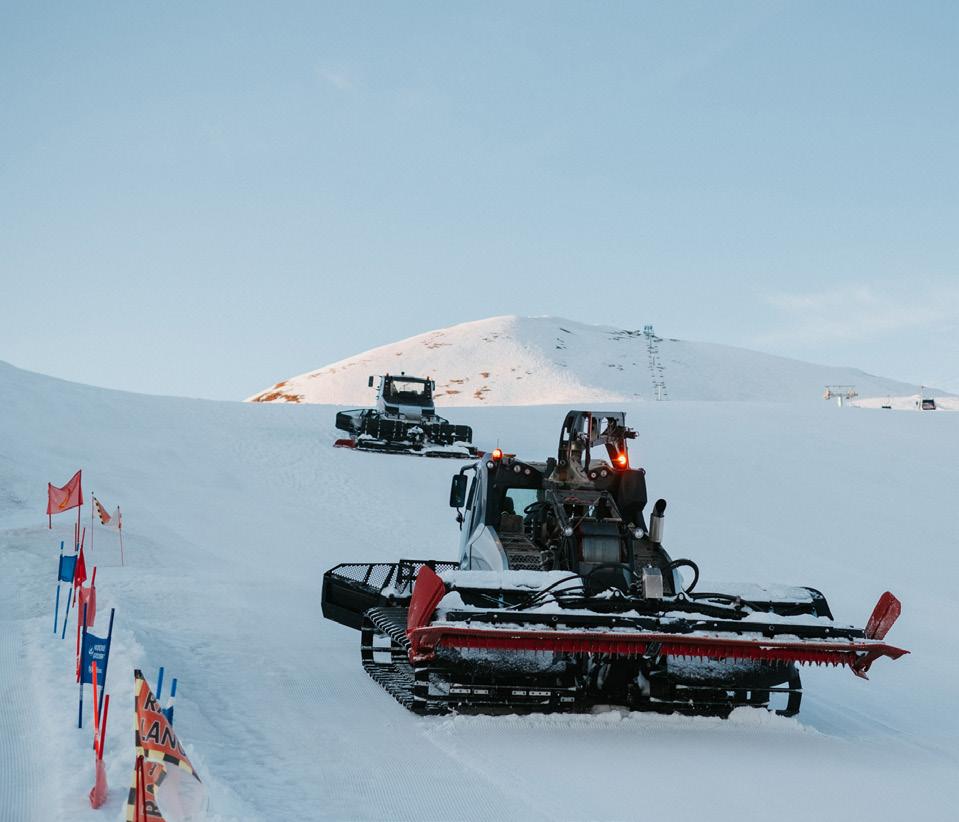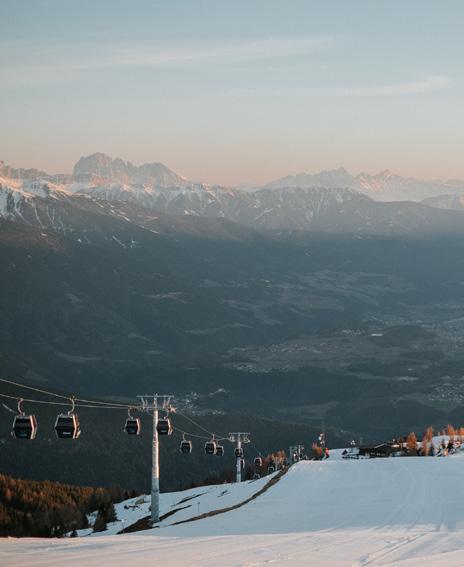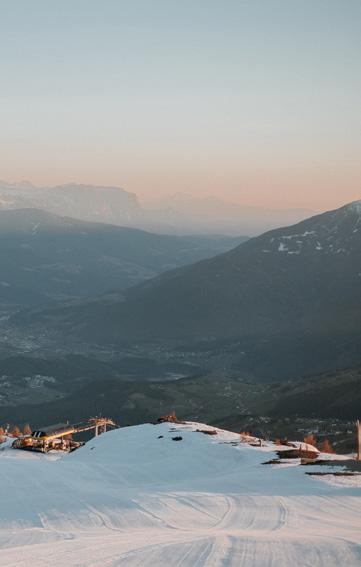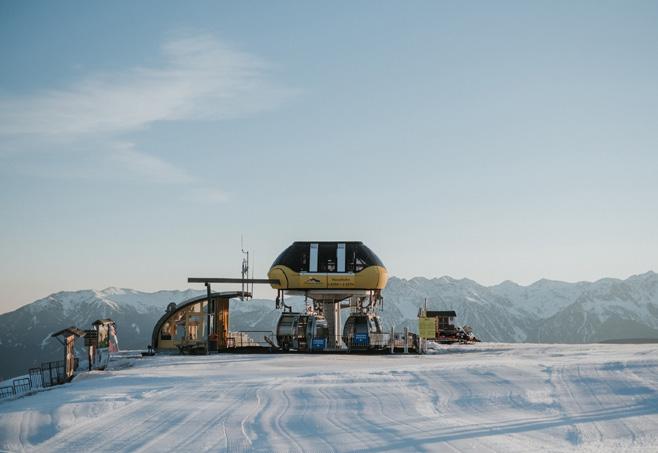
9 minute read
A Day with... Snowcat driver Konrad Unterkircher
A Day with... a Snowcat Driver
The Gitschberg Jochtal ski & holiday area is Konrad Unterkircher’s stomping ground. We spent 24 hours out and about with a man who is on the slopes day and night
Advertisement

Text — MARIANNA KASTLUNGER Photos — MICHAEL PEZZEI



The Gitschberg Jochtal ski & holiday area lies at an altitude of between 1,300 and 2,500 metres and has more than 55 kilometres of slopes.
Konrad’s snowcat is 10 metres in length, weighs 14 tonnes and cost half a million euros. It has an output of 530 hp, two drive motors and a working width of 6 metres.
3:00am

When your work day is dictated by wind, storms, sun, snow and rain, you have to be flexible. Luckily, flexibility is Konrad Unterkircher’s middle name – his job leaves him with no other choice. Whenever a few centimetres of snow cover the Pfunderer mountains overnight, the 62-year-old slope manager and two of his colleagues meet up at the southern slope in the dark. This is exactly where they find themselves tonight. They now have five and a half hours to flatten the fresh snow with their snowcats – five and a half hours of high-precision work during which they can’t take their eyes off the ball. Konrad only takes a break when the morning’s first skiers start populating the slopes. And by break, we don’t mean his work is done. Far from it – his day has only just begun. “A typical work routine?” he says, laughing. “There’s no such thing!”
11:30am

Konrad is a slope manager, snowcat driver and slope inspector all rolled into one. He’s been part of the furniture here for decades. His place of work, the Gitschberg Jochtal ski & holiday area, lies at an altitude of between 1,300 and 2,500 metres and has more than 55 kilometres of slopes. He grew up on his parents’ farm in the nearby village of Weitental/Vallarga and was fascinated by tracked vehicles and diggers even at a young age. The day has dawned and the snow clouds have blown over. The sun is shining and Konrad is beaming. He’s swapped his snowcat for a pair of skis. If you were to watch him weaving his way down the slopes, you wouldn’t think that he was hard at work. He explains that he’s performing his daily slope inspection, which requires him to test the snow conditions on each downhill run in person. Konrad takes off his skis in front of the Gitschhütte mountain lodge, which his son Meinrad has been running for 15 years. Today, an après-ski party will be held on the terrace. Konrad is not only a slope manager, but a trained chef as well, and he helps
out wherever he is needed. He knows a lot of people up here and greets everyone with a friendly smile. A popular German song with the lyrics “Above the clouds, freedom must know no bounds” can be heard playing through the speakers. Meinrad rushes into the kitchen from the bar, while his father serves traditional cheese dumplings, omelettes and goulash to the waiting guests.
2:11pm
Konrad checks over the snowcat, which he has parked behind the Gitschhütte in the morning. The behemoth of a vehicle goes by many names, including snow groomer, piste machine, trail groomer and piste basher. “In the South Tyrolean dialect, the word for snowcat is Schneakåtz,” says Konrad. You need a category C driving licence and additional training in tracked vehicles to drive a Schneakåtz. Konrad has been riding around in vehicles like this since the early 1970s and does so almost every day in winter. He has enjoyed operating each and every one of the 12 models he has used over the decades: “Machines like this are so much fun to drive. But it takes an age to learn how to master them.” Including the tiller, Konrad’s current vehicle measures almost 10 metres in length, weighs in at a staggering 14 tonnes and costs half a million euros. It has an output of 530 hp, two drive motors and a working width of 6 metres. The vehicle needs to be inspected every day to check its water
Did you know...
... that the word “ski” comes from the Old Norse word skíð, which means “stick of wood”?
... that archaeologists in China have found 5,000-year-old paintings showing our ancestors on skis?
... that there are more than 2,000 ski resorts with a total of around 27,000 lifts worldwide? A third of these are in the Alps.
... the fastest skiing speed ever recorded is 255 kilometres per hour? The average skiing speed is 50 kilometres per hour.

level and to make sure there is enough fuel in the tank. Konrad also looks at the hydraulics and engine oil level. Only after all of these checks is he satisfied that the snowcat is ready to roll.
4:15pm
The Gitschlift chair lift has stopped for the day. The last skiers are winding their way back down into the valley. The mountain is slowly becoming deserted again. Konrad radios his two colleagues. All three machines are raring to go – and so they set off once more. With the sun starting to set behind them, they work together to prepare the slopes around the summit, their practised movements back and forwards resembling a synchronised dance. The purr of the snowcats is surprisingly soft. Before his last descent on this section of the mountain, Konrad makes a detour to the viewing platform. From here, the panoramic view extends in all directions and you can gaze out at more than 500 summits, including the Pfunderer mountains, the Dolomites and the Plose ski resort. “Spectacular, isn’t it?” he says, pausing for a moment, looking pensive. Then it’s back to work.
There isn’t much space to reverse the snowcat. Konrad concentrates hard as he manoeuvres the vehicle along the steep precipice. “Visibility is good today so we can find our way without too much trouble,” he explains. The driver’s cab is comfortable and the on-board computer makes the machine easier to drive, continuously providing data on the depth

of the snow being flattened. “Even so, you still need to know the terrain inside out,” says Konrad, “so that you can control the vehicle in fog or other challenging weather conditions.”
5:15pm
Konrad radios one of his colleagues. “Alfred, there’s nobody left up here apart from the lodge staff.” All 15 of the skiing area’s cable cars have closed for the night and the three slope workers are the only ones still out on the snow. They discuss which area each of them should take care of over the radio and will warn each other if they should unexpectedly happen to come across any skiers returning to the


Across South Tyrol there are around 30 skiing areas with approx. 1,211 kilometres of slopes that need to be groomed every day.
valley station. Today, Konrad is taking care of the Segerwiese and Nesselwiese slopes, where the gradients are as steep as 37 percent. That means it’s time to deploy the winch in order to secure the snowcat. Usually, the winch is easy to control remotely but it’s playing up this evening. “It’s the batteries,” suspects the slope manager, jumping out of the driver’s cab to check the winch. He’s right. The batteries are indeed on the blink. He winds the winch out manually, pulls out the metal cable with its heavy metal hook by a few metres and attaches it to a special cement post. This will now serve as a fixed anchor for the snowcat as it works on the steep slope.
5:52pm
later became responsible for training his future colleagues. What does he love most about his job? “Being able to see the beautiful slopes I leave behind me,” he replies without hesitation. And what doesn’t he like? He merely shrugs his shoulders and smiles happily.
On steep terrain, the roughly 1,200-metre-long cable supports the snow groomer, especially as it is driven uphill. “When the cable pulls tight, you absolutely need to keep your distance because it can be very, very dangerous,” says Konrad, pointing upwards at the very moment that the winch pulls the cable in again. The increased tension on the slope causes the rope to shoot suddenly across the snow as fast as a whiplash. This is exactly why the snow grooming team only gets to work once the slopes have closed for the day. The lodges are open in line with the cable car operating times, while designated areas are bordered off once a week to make them safe for night ski touring enthusiasts. The slope workers conduct regular drills to make sure they are properly handling the winch. These training exercises are even important for experienced drivers like Konrad. He’s been doing this job since 1972, just two years after the skiing area was first opened. “Back then I was the only slope worker. I had to teach myself how to do everything,” he says. He
8:45pm
Little by little, the undulating slopes are being transformed into flat, uniform expanses of snow. “The snow is soft and easy to smooth down today,” says Konrad. This means that he only needs to drive the snowcat over each slope once. There’s enough real snow here this evening that there is no call for any artificial snow, which tends to be more stubborn. “When this isn’t the case, we might have to roll over it three times a night until it’s right.” Precision is key. Konrad takes particular care at the crossing points to ensure that the edges of the groomed areas merge seamlessly into the bordering regions. “We don’t want any lumps to form and harden overnight,” he says. He doesn’t take a break and shows no signs of fatigue. He’s also never bored: “I just love the panoramic views here, in any light and in all seasons. There’s always a new angle to discover.”

9:00pm
The favourable temperatures which have left the snow so soft and smooth allow the team to clock off earlier than is sometimes the case. Konrad and his colleagues eat dinner together, all the while keeping a close eye on the latest weather report. The sky has clouded over again, it looks like more snow is going to fall overnight. That means another bright and early start: in just a few hours, it will be time to do it all over again.











